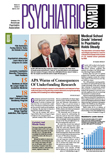Suicide is an occupational hazard of psychiatry. Residency directors should prepare their trainees for what can be a devastating trauma when a patient being treated in the program kills himself or herself, said Eric Plakun, M.D., and Jane Tillman, Ph.D., during a workshop at the annual meeting of the American Association of Directors of Psychiatric Residency Training (AADPRT) last month in San Juan, Puerto Rico. And though lawyers are liable to advise silence in the aftermath of a suicide, training directors need to devise a way for trainees and faculty to discuss the trauma.
Plakun cited research indicating that 1 in 6 psychology trainees and 1 in 3 psychiatry residents will experience the suicide of a patient during training.“ It's an event that obviously affects the resident whose patient has committed suicide, but it also often affects the whole system,” he said.
Plakun is director of admissions and professional relations at the Austen Riggs Center in Stockbridge, Mass.
Patient's Suicide Must Be Discussed
In the aftermath of a suicide, a “sentinel event” inquiry is likely to occur, typically undertaken by a small group from the hospital administration, with the information about the event kept under wraps in keeping with an overall recommendation not to talk about the findings.
Plakun said that lawyers usually will advise a program not to discuss the circumstances of the suicide for fear that discussions can be discoverable in a trial.
“But what is good legal advice is not necessarily good clinical or training advice,” he said. “You have to find a way to create a space to talk about the event. Otherwise, there can be splits in the system when reactions go underground.”
By way of example, Plakun cited an instance where in the aftermath of a patient's suicide, residents formed an animosity toward faculty and administration because they believed that the trainee whose patient had completed suicide was being blamed unfairly for the event. Plakun said that many states have legal mechanisms through which discussions can be protected from legal discovery.
“Residency training directors are crucial to planning a separate review of the event that is focused on the impact of the death on clinicians as human beings,” he said. “There are ways to do this even if it means inviting the hospital attorney so that the meeting is protected by attorney-client privilege.”
In November 2006 the APA Assembly adopted an action paper declaring suicide an occupational hazard for psychiatrists and recommending that the Residency Review Committee in Psychiatry include training on the impact in the next revision of the psychiatry residency curriculum.
The action paper also requests APA to publicize and make available on the APA Web site, as a benefit of membership, a narrated PowerPoint presentation offering education to psychiatrists about the impact of patient suicide and how to deal with it. It also would have APA undertake a feasibility study of developing confidential telephone consultation, on a national or district branch level, for member psychiatrists who have had a patient die by suicide.
The action paper has been referred by the Joint Reference Committee to the Council on Medical Education and Career Development.
Not a Rare Occurrence
Plakun said studies vary on the frequency of suicide among patients of psychiatrists in practice, but it appears to be a common event.
At the AADPRT workshop, Tillman outlined findings from her study published in the February 2006 International Journal of Psychoanalysis on the reactions of 12 psychoanalytic clinicians to a patient suicide (see“ Reactions to Patient Suicide Deep, Long Lasting”).
Even allowing for the fact that attendees were self-selecting the topic, the frequency with which suicide touches a residency was strikingly apparent at the AADPRT workshop; among approximately 16 program directors in attendance, all of them indicated having been affected in some way by a patient suicide.
The sentiment was crystallized by the following testimony of one residency director who, like others at the workshop, asked not to be identified by name or institution:
“I had a third-year resident who was treating a patient who committed suicide. I was her long-term supervisor, so I knew this resident very well and felt that she was a very gifted psychiatrist. But she was utterly devastated, questioning her fitness as a physician and her choice of psychiatry as a specialty.
“As someone who really cared about her, I felt so much like I wanted to say the right thing, to help her grow and get beyond this event. Yet I felt powerless because no matter what I said, I was unable to get her to see her worth.”
Plakun said training programs should be teaching their residents about suicide as an occupational hazard. He cited the words of Robert Simon, M.D., who wrote in his 2004 book Assessing and Managing Suicide Risk: Guidelines for Clinically Based Risk Management, “There are only two kinds of psychiatrists, those who have had a patient commit suicide and those who will.”
“If we were coal miners, we would be teaching about black-lung disease and how to use a mask for protection,” he said.
Plakun offered the following tips for training directors in the wake of a patient's suicide:
•
Don't leave the resident whose patient has committed suicide in isolation.
•
Convene and participate in a nonjudgmental review of the suicide using role-related groups when possible.
•
Share your own experiences.
•
Be aware of the inevitability of counter-transference guilt and self-doubt.
Meeting with the patient's family members is likely to be the most difficult task.
“Plan in advance how you will manage the confidentiality barrier,” Plakun advised. “Don't be blindsided. You need to offer a blame-free, nonjudgmental, and nondefensive space to recognize and contain their grief, anger, and blame.
“Offer your genuine condolences without self-criticism,” he said. “And remember that the primary purpose is to meet the family's needs, not your own.” ▪
